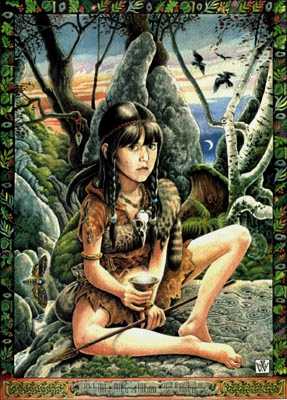| Celts Page 2 
Celts in Ireland and Britain The indigenous populations of Britain and Ireland today are primarily descended from the ancient peoples that have always inhabited these lands. As to their culture, little is known but remnants remain primarily in the naming of certain geographical features, such as the rivers Clyde, Tamar, Thames and Tyne. By the Roman period most of the inhabitants of the isles of Ireland and Great Britain (the ancient Britons) were speaking Goidelic or Brythonic languages, close counterparts to Gaulish languages spoken on the European mainland. Historians explained this as the result of successive invasions from the European continent by diverse Celtic-speaking peoples over the course of several centuries. In 1946 the Celtic scholar T. F. O'Rahilly published his extremely influential model of the early history of Ireland which postulated four separate waves of Celtic invaders. What languages were spoken by the peoples Ireland and Britain before the arrival of the Celts is unknown. Later research indicated that the language and culture had developed gradually and continuously, and in Ireland no archaeological evidence was found for large intrusive groups of Celtic immigrants, suggesting to historians such as Colin Renfrew that the native Late Bronze Age inhabitants gradually absorbed influences to create "Celtic" culture. The very few continental La Tène culture style objects which had been found in Ireland could have been imports, or the possessions of a few rich immigrants. Julius Caesar had written of people in Britain who came from Belgium (the Belgae), but archaeological evidence which was interpreted in the 1930s as confirming this was contradicted by later interpretations and it was suggested that there might have been only a handful of élite Belgae in Britain. In the 1970s this model was popularised by Colin Burgess in his book The Age of Stonehenge which theorised that Celtic culture in Great Britain "emerged" rather than resulted from invasion and that the Celts were not invading aliens, but the descendants of the people of Stonehenge. More recently a number of genetic studies have supported this model of culture being absorbed by native populations. The study by Cristian Capelli, David Goldstein and others at University College, London showed that genes associated with Gaelic names in Ireland and Scotland are also common in Wales, Cornwall and most parts England, and are similar to the genes of the Basque people, who speak a non-Indo-European language. This similarity supported earlier findings in suggesting a largely pre-Celtic genetic ancestry, possibly going back to the Paleolithic. They suggest that 'Celtic' culture and the Celtic language were imported to Britain by cultural contact not mass invasions, either by Indo-Europeans bringing farming or by Celts in 600 BC. Some recent studies have suggested that, contrary to long-standing beliefs, the Teuton tribes did not wipe out the Romano-British of England but rather, over the course of six centuries, conquered the native Brythonic people of what is now England and south east Scotland and imposed their culture and language upon them, in a manner similar to the Irish spread over the west of Scotland. Roman Influence At the dawn of history in Europe, the Celts in present-day France were known as Gauls. Their descendants were described by Julius Caesar in his Gallic Wars. There was also an early Celtic presence in northern Italy. Other Celtic tribes invaded Italy, establishing there a city they called Mediolanum (modern Milan) and sacking Rome itself in 390 BC following the Battle of the Allia. A century later the defeat of the combined Samnite, Celtic and Etruscan alliance by the Romans in the Third Samnite War sounded the end of the Celtic domination in Europe, but it was not until 192 BC that the Roman armies conquered the last remaining independent Celtic kingdoms in Italy. Under Caesar the Romans conquered Celtic Gaul, and from Claudius onward the Roman empire absorbed parts of the Celtic British Isles. Roman local government of these regions closely mirrored pre-Roman 'tribal' boundaries, and archaeological finds suggest native involvement in local government. Latin was the official language of these regions after the conquests.The native peoples under Roman rule became Romanized and keen to adopt Roman ways. Celtic art had already incorporated classical influences, and surviving Gallo-Roman pieces interpret classical subjects or keep faith with old traditions despite a Roman overlay. Roman influence lead directly to the decline of the druidic priests. Prior to Roman conquests, the druids exercised enormous spiritual and political power among the celtic peoples. The druidic religion was seen as a major impediment to the "Romanization" of the newly conquered celts. Thus began a deliberate policy on the part of the Roman conquerors to replace the old celtic political structure with Roman institutions. The elimination of the druidic class was instrumental to cementing Roman authority. This led the birth of many Romano-celtic deities, as old celtic gods took on new latin names and aspects of Roman divinities, and began to be worshipped alongside the more traditional Jovian pantheon. Info found on Crystalinks.com For Next Page 
|  Free Forum Hosting
Free Forum Hosting